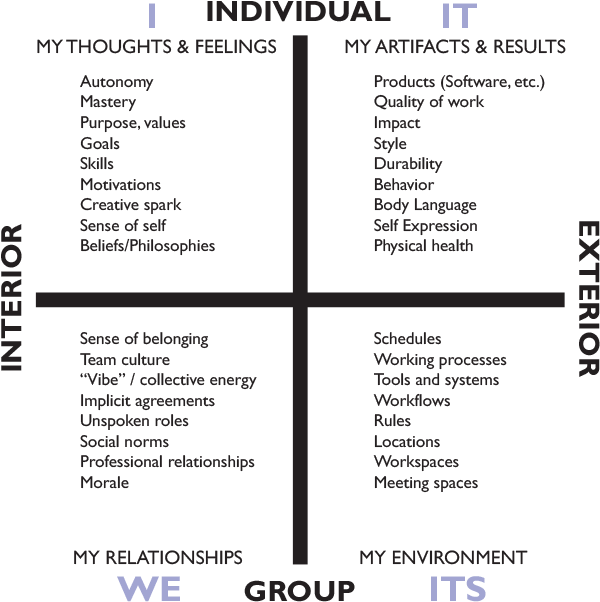The word integral means comprehensive, inclusive, non-marginalizing, embracing. Integral approaches to any field attempt to be exactly that: to include as many perspectives, styles, and methodologies as possible within a coherent view of the topic. In a certain sense, integral approaches are “meta-paradigms,” or ways to draw together an already existing number of separate paradigms into an interrelated network of approaches that are mutually enriching.
- Ken Wilber
What is Integral Theory?
During the last 40 years we have witnessed a historical first: all of the world's cultures are now available to us. Knowledge itself is now global, that means that also, for the first time, the sum total of all human knowledge is available to us. What if we took literally everything that all the various cultures have to tell us about human potential and put it all on the table? What if we attempted, based on extensive cross-cultural study to use all of the world's great traditions to create a comprehensive map that included the best from all of them?
Over the last several decaces, Ken Wilber and others have lead a search for this comprehansive map of human potentials. This map uses all the known systems and models of human growth - from the ancient shamans and sages to today's breakthroughs in cognitive science - and distills their components into 5 simple factors, factors that are essential elements to unlocking the and facilitating human evolution.
This is the integral approach.
Holons (whole parts)

A holon is something that is simultaneously a whole and a part. Holons are self-reliant units that possess a degree of independence and can handle contingencies without asking higher authorities for instructions. These holons are also simultaneously subject to control from one or more of these higher authorities.
A hierarchy of holons is called a holarchy. The test of holarchy is that if all instances of a given type of holon cease to exist, then all the holons they were part of must cease to exist too. Thus an atom is of a lower standing in the hierarchy than a molecule, because if you removed all molecules, atoms could still exist, whereas if you removed all atoms, molecules, in a strict sense would cease to exist. Ken Wilber's concept is known as the doctrine of the fundamental and the significant. A hydrogen atom is more fundamental than an ant, but an ant is more significant.
Quadrants
Each holon can be seen from within (subjective, interior perspective) and from the outside (objective, exterior perspective), and from an individual or a collective perspective.
All four perspectives are complementary, rather than contradictory. It is possible for all to be correct, and all are necessary for a complete account of human existence. Each by itself offers only a partial view of reality.
Each quadrant is as valid as reality in the others; no quadrant can be reduced to the others. No exception. For instance, your felt emotion is not less real than electro-chemical reactions in your brain. It is the same "thing" but looked at from a different perspective, both being real.
Second Tier
Levels
Levels in Integral Theory refers to stages of evolutionary development of individuals, organizations, societies, and indeed our species as a whole. It is based on the works of Clare W. Graves, Don E. Beck, and Christopher Cowan, and became a part of Integral Theory through collaboration between Don Beck and Ken Wilber.
These levels or stages of development describe how our various value systems influence our world views, with the intent being to replace skin pigmentation or ethnic categories with an understanding of value systems. Graves was able to prove through various studies that these value systems have a greater influence on affinity and the ability to collaborate and see other people’s point of view than race or skin color. Don Beck achieved historic success using these principles to help bring an end to Apartheid over the course of 63 visits to South Africa.
Moving through the various different levels is dependent on cognitive development (different levels are available as a person grows into adulthood), and life conditions supporting a move to the next stage. No level is inherently positive or negative, each has their gifts and problems and each new level a person moves through is developed as a response to solving the problems encountered at the previous level.
Click on a level to view details
Holistic
World centric - Starting 50 years ago
Authentic irony, Ecology of perspectives
Quest: Peace in an incomprensible world Transrational perceptions, AQAL
Pitfalls: pathologies of the soul
.1% of the world, 1% of power
Integral
Integrated individualism - Starting 70 years ago
Live fully and responsibly. Integrate the whole spiral
Quest: Integral synthesis - to balance the whole Evolutionary streams awaken, integrate diversity with discernment, healthy heirarchies (holoarchies)
Pitfalls: aborted self-actualization, existential angst, bad faith, withdrawal
1% of the world, 5% of power
Sensitive
Age 15-21 years years Social Democracies -Starting 150 years ago
Seek inner pease within a caring community. Power with solidarity, human rights activism
Quest: affectionate relations, beneficial resolution, dialogue and consensus
Method: appreciate diverse views, listen well, consensus, empathicize group needs, marginalize no one
Pitfalls: inauthenticity, lack of discernment, directionless attempts at consensus, hostile towards heirarchies, flatland
10% of the world, 15% of power
Achiever
Age 9-14 years/Capitalistic Democracies - Starting 300 years ago - Scientific Rationalism
Act from self interest, play the game to win, market driven meritocracy
Quest: material pleasure, defense of civilization
Method: excel, set goals, acheive, measure success
Pitfalls: identity crisis, role confusions, consumerism ecological crisis workaholism, denial of spirit
30% of the world, 50% of power
Rule/Role
Age 7-8 years/Late mythic, Nation States, Authoritarian, Conformist Religious - starting 5,000 years ago
Life has meaning, direction, purpose, predetermined outcomes
Quest: good vs evil, ultimate peace
Method: follow given rules, discipline, faith, know your role
Pitfalls: archtypal role identification, fundamentalism, facism
40% of the world, 30% of power
Impulsive
Age 3-6 years/Early mythic, feudal - starting 10,000 years ago
Be what you are and do what you want, regardless of consequence
Quest: heroic status, power, glory, rage, revenge
Method: align with power, take what you need, force, rule
Pitfalls: anxiety, depression, phobias, excessive guilt, terrorism
20% of the world, 5% of power
Magic
Age 1-3 years/Tribal order - starting 50,000 years ago
Magical thinking, keep the spirits happy and the tribe safe
Quest: safe mode of living, security
Method: petition to gods or powers with ritual
Pitfalls: narcissism, omnipotent fantasy, tribal conflicts
10% of world, 1% of power
Instinctive
Age 0-18 months/Survival bands - starting 100,000 years ago
Do what you need to stay alive. Pure narcisstic behaviors.
Quest: food, water, warmth, shelter
Method: scavenge whatever you need
Pitfalls: primitive developmental psycho pathologies, autism
First Tier
Lines of Intelligence or Development
If you were to hear that someone was intelligent, what’s the first thing you think of? Is it doing well in school? Rocket science or brain surgery perhaps? Lines of Intelligence adds needed depth to our typically reductive ideas of what it means to be intelligent by answering questions such as “why is it that a person with an IQ of 160 can find themselves unable to apply that cognitive ability in many situations?”
Lines additionally expand on the Levels of Development, if a person’s value system is predominantly green, for example, they are likely not green across the board. Our example follows a well meaning gent by the name of Gil. Gil is a 30 year old working in new product development in a large company. He is passionate about new ways people can share experiences, and always tries to respect others and put their needs first. At this point in his life, his Lines of Intelligence are as follows.
| Instinctive | Magic | Impulsive | Rule/Role | Achiever | Sensitive | Integral | |
| Cognitive | Instinctive | Magic | Impulsive | Rule/Role | Achiever | Sensitive | Integral |
| Emotional Intrapersonal | Instinctive | Magic | Impulsive | Rule/Role | Achiever | Sensitive | Integral |
| Emotional Interpersonal | Instinctive | Magic | Impulsive | Rule/Role | Achiever | Sensitive | Integral |
| Somatic | Instinctive | Magic | Impulsive | Rule/Role | Achiever | Sensitive | Integral |
| Moral | Instinctive | Magic | Impulsive | Rule/Role | Achiever | Sensitive | Integral |
| Spiritual | Instinctive | Magic | Impulsive | Rule/Role | Achiever | Sensitive | Integral |
| Willpower | Instinctive | Magic | Impulsive | Rule/Role | Achiever | Sensitive | Integral |
View all lines descriptions
Cognitive Abstract:
The cognitive line refers to the capacity to take on different perspectives. Development through this line begins with a person believing their own perspective is the ultimate truth, and moves through various different stages towards a universe that contains infinite perspectives and possibilities. Progression through the cognitive intelligence line enables being able to take the perspectives of others around you, imagine conditional possibilities, and hold contradictory ideas simultaneously allowing the charting of a path forward in a complex world.
Gil’s Cognitive:
Gil has the capacity to understand the views of others in relation to his own, and frequently works towards an outcome that will be suitable for everyone. This is a “world centric” perspective, so Gil identifies with humanity as a whole regardless of race, religion, or nationality. He strives for equality and inclusion, and prefers to collaborate with diverse perspectives in any endeavor, believing that this creates a richer result.
Emotional Intrapersonal Abstract:
The emotional intrapersonal line refers to the capacity to introspect and report what you see, feel and think. This is often referred to as emotional intelligence or self awareness. Development through his line begins with blindly following every experienced impulse or desire, and moves through various stages towards an ability to identify the source of the felt experience. Progression through the intrapersonal line enables a person who is experiencing very strong emotions such as anger, desire, or terror in a given situation to take a step back and assess whether those feelings are in fact being triggered by the current situation, or are from old wounds or a misinterpretation of events. They can then consciously choose how, or if, to act or express.
Gil’s Intrapersonal:
Gil is a person who has always strongly identified with his own feelings, and although he deeply cares about other people, he is ruled by his own needs and impulses. On occasions this results in hurt and arguments, he feels very confused and misunderstood by those around him often wondering why his good intentions aren’t enough. He doesn’t notice when he’s raising his voice, or that he took the last cookie, and will often storm out of a room if frustrated or angry.
Emotional Interpersonal Abstract:
The emotional interpersonal line refers to the ability to register what another person is feeling and the interaction between your own and their emotional states. This is often referred to as empathy, and involves reading verbal and non-verbal cues, it also determines a person’s ability to relate socially and communicate with others. Development through this line begins with seeing others as no different than objects such a chair or a smart phone - they exist to serve your needs -and moves through various stages towards the ability to deeply feel another person’s experience. Progression through the interpersonal line expands a person’s ability to have more and deeper relationships, and better navigate social situations. People who are very high in this line are experienced as charismatic and draw people towards them.
Gil’s Interpersonal:
Gil is affable and easy to be around, most of the time. Although his awareness of his own feelings is limited, he has an instinctual ability to read people and adapt to their changing moods and needs. He is an effective communicator who can command and keep the attention of the room during presentations. He has many friends and is generally well liked at work.
Somatic Abstract:
The somatic line refers to bodily awareness, strength and coordination. Development through this line begins with an infant learning their body exists and is separate from the world, and proceeds through an ever increasing awareness of how to move through various environments. Progression through this line usually depends on where a person applies themselves, but can include things like athletics, surgery, art, dance, and control of one’s breath.
Gil’s Somatic:
Gil has a general awareness of his body in most environments, and doesn’t have difficulty navigating through the world. He goes to the gym occasionally and tries to generally stay healthy, but his investment in his body and physical skills is limited as his interests lie elsewhere.
Moral Abstract:
The moral line refers to the capacity to tell the right thing to do in a given circumstance. Development of this line begins with the egocentric - what is the best thing to do for me? It then moves to the ethnocentric - what is the best thing to do for my group - country, race, creed, etc., where the definition of the right thing to do is governed by laws and doctrine. It then proceeds to a world centric morality that considers the right thing to do based on an internally driven sense of conscience and fairness.
Gil’s Moral:
Gil’s decisions are driven by a desire to positively impact the individuals and communities he encounters and generally make the world a better place to live. He treats everyone equally, donates to charity and volunteers his time to help those less fortunate. He is an honest person, and does his best to always represent what is true and what he feels is right and fair.
Spiritual Abstract:
The spiritual line refers to the capacity to explore what really matters to you. Development of this line begins with no awareness or ability to look inside, grows through being told what’s important by authority figures, and later moves into being able to develop an internal sense of purpose and the value one has to offer to the world.
Gil’s Spiritual:
Gil feels deeply connected to his personal purpose, which is to leave every situation better than he found it through his own creative expression. This is what attracted him to his current role of building new products to connect people with each other. He has yet to discover the specific personal expression of that purpose, and is happy to contribute in his current role until he discovers the unique gift he has to offer the world.
Willpower Abstract:
The willpower line determines the actions a person chooses to take. Without willpower, a person can have deeper understanding or clearer seeing, but will not realize actual change or impact. Willpower is the ability to set a goal and see it through to the end despite obstacles.
Gil’s Willpower:
Gil is most successful following through on his goals and commitments when he is driven by a desire to win or succeed. If he can’t see the clear path to something tangibly getting better, he has trouble doing what he knows he should even if he feels like it’s the right thing to do. This sometimes leaves him with feelings of guilt or shame, which he hides with excuses and a defensive posture.





